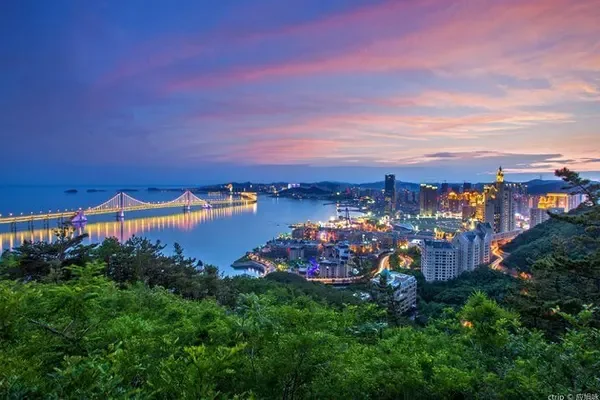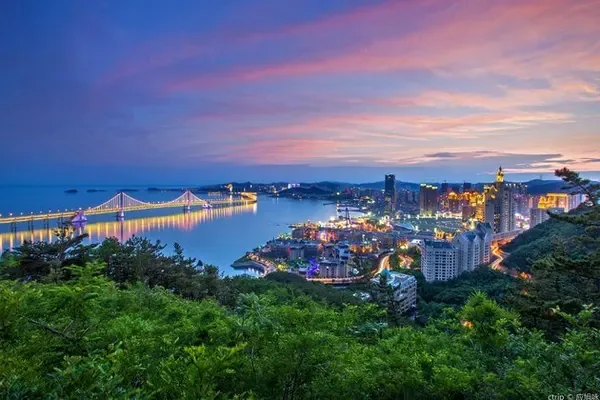The Chinese horticultural display area condenses the essence of Chinese land gardens. The Shanghai Garden is just passing by. The antique archway on the opposite side is eye-catching, with the inscription "Beijing Garden" on the plaque. One step at a time in the garden, it is worth enjoying carefully. There is a saying: pass the archway and walk the flower path, the hutong courtyard has deep vegetation; walk through the gallery and step on the stone bridge, the pavilions and pavilions are secluded.




Through various landscaping borrowings, the Beijing Garden uses buildings and flowers to create eight picturesque scrolls of harmony and wishful thinking, green tiles in full bloom, Tanghua innocence, Yutang Changchun, sweet rain and lotus wind, deepness of hundreds of flowers, green peaks and shadows, and assorted flower houses. Here you can taste the spring flowers and autumn fruits of the courtyard house, feel the customs of old Beijing, and feel leisurely in it.




The entrance of the Jiangxi Garden is set against the porcelain-painted mountain screen in Tang Yin's "Mount Lu Mountain", decorated with rhododendron piles and other flowers and plants. The rockery, hills, flower fields, lawns, bamboo houses, and water features in the park are integrated into one. This is a "paradise" hidden among bamboo forests and mountains and rivers, which reproduces the landscape image of "picking chrysanthemums under the eastern fence and seeing Nanshan leisurely". .




Pass through the bamboo archway and come to Zhejiang Garden. The scenic spots are listed one or two. "Yingmeng Jiangnan" shows beautiful mountains and rivers through rockery and falling water; "Hushan Poetry" depicts graceful picturesque scrolls of lakes and mountains through characteristic landscape walls; "Xidie Yayuan" is a courtyard landscape based on traditional buildings. There is also a miniature version of the Three Pools Reflecting the Moon here, which makes people remember Jiangnan.




In the middle of the Hebei Garden is a wide water area, and the scenic spots are all around. The evolution from natural scenery to cultural landscape reflects the vigorous and simple style. The mountains are miniature and the flowers are blooming. When I visit here, I can't help but feel a lot of nonsense: the Great Wall, the scenic spot on the Taihang Mountain; Xiong'an New District, the grand plan of Baiyangdian.




White walls and black tiles, beautiful Jiangsu, how can I miss it. In the park, the four landscape areas, which are full of spring, surrounded by lotus wind, rich and noble, and dark fragrance and sparse shadow, are organically integrated to show the charm of Jiangnan gardens. There is a saying: bonsai are placed in pavilions, halls and squares, houses with small bridges and flowing water; rockeries are displayed among flowers and bamboos, and gardens with winding paths to listen to the rain.




The landscape stones with unique regional characteristics in various provinces, municipalities and autonomous regions across the country are displayed in a circular form in the Peer Square, implying that the Chinese nation is of one heart and one mind, forging ahead together, and moving forward together. There are many strange stones here, including "Taishan Stone" from Shandong, "Xiuyan Jade" from Liaoning, "Shoushan Stone" from Fujian, "Qilian Jade" from Gansu and so on.




The vermilion gate comes into view, and the Shanxi folk houses appear in front of you. Walking on the wall-hanging trails and walking through the strange rocks, there is a saying: at the foot of the majestic Taihang Mountains, brick carvings, wood carvings, stone carvings, and painted pillars and beams; The mountain streams and waterfalls are pouring down, and the flowers under the trees are in full bloom. People say that Shanxi has beautiful scenery, and the land of the Three Jin Dynasties is beautiful.




Fortified in the south of the Yangtze River, the impression of Ningxia is that the majestic Liupan Mountains, the Jiuqu Yellow River, and the quaint folk houses form a landscape pattern of "one mountain, one river, and one folk house". Approaching Gansu, the desert Dunhuang flies to the sky to pursue dreams, and the Silk Road flowers and rain dance in Gansu. Passing by Inner Mongolia, green grass and wild flowers Matouqin, blue sky and white clouds yurts, beautiful grassland my home.




Qinghai has a vast territory, just pass by, the source of the three rivers is gurgling, and Qinghai is beautiful with green grass. Each park has its own regional characteristics. Due to limited time, I can only choose to visit, which is a bit regrettable. There is a saying: Xinjiang is a good place, with melons and fruits fragrant in the north and south of the Tianshan Mountains; I have been in front of Jilin Gate in Liaoning, but I have not been to Tianjin and Heilongjiang.




Entering the Shaanxi Garden, the four red bucket arches that look like bonsai and flower baskets are exquisite and beautiful, attracting attention. Walking along the winding trail, you can see the mountains and rivers of the Sanqin, and the exotic flowers and trees in the Guanzhong Plain. Going back the same way and coming to the Tibetan area, I saw: the snowy landscape, the colorful Gesang flowers on the prayer flags, the plateau scenery, and the endless multiplication of yaks and willows.




Floating over the Chongqing Garden, we stayed in the Sichuan Garden. In front of us is the Dujiangyan Water Conservancy Irrigation Project built with rockery and used for the present, as well as the Jiuzhaigou Huanglong Scenic Area. To experience the style of Tianfu, a mahjong table is placed next to the folk houses in western Sichuan, and several clumps of hibiscus are blooming; to witness the wonders of Bashu, several groups of bonsai piles are placed in the panda home, and a piece of green bamboo is swaying.




The Chongguang Gate of the Confucian Mansion in Qufu has a plaque inscribed on the Qilu Garden. There are piles of stones, mountains and rivers, and flowers are everywhere. Danxia landform, hundreds of miles of rhododendrons, passing through the small seven holes in Libo, and coming to Tongren Fanjing Mountain, a Guiyun garden condenses the unique scenery of Guizhou.




Stepping into the gate tower of the Dai family, you can see the roots of golden lotus in the ground; walking along the ancient tea-horse road, you can see the lush branches and leaves of tea trees. Exotic flowers and trees, fragrant clouds and medicines, what a colorful Yunnan: mountains and rivers as the base, rivers as veins, real mountains and waters restore the magical landforms of the plant kingdom;




Passing by Henan Garden, Hunan meets Peach Blossom Spring. The rocks of Wuling Mountains, the Chunhui of Dongting, the purple rain of Xianglian, the beauty of Furong Country; a courtyard, a vegetable field, and a wooden boat, the land of Xiaoxiang is full of spring. It can be said that if you paint with mountains and rivers, there is Junshan in Dongting Lake; if you write poems with rural areas, you can cultivate fields in the peach blossom garden.




The phoenix dances in Jingchu, with beautiful landscapes. When you come to Hubei Garden, there is a saying: the green mountains, green waters and lakes are shining; Passing through the towering "Huifeng Wanyun" archway, the five main scenic spots such as Nanhu Poetry, Huiyun Liufang, and Baizhang Waterfall condense the beautiful picture scroll of Anhui. Leaning on the Green Corridor.




When you come to Hainan Garden, walk through the dreamy flower gallery, the coconut trees dancing in the shadows, the bougainvillea, and the island landscape created by mountains, seas and forests will make you linger forever. Take a leisurely stroll in the Guangxi Garden to experience the unique charm of the Zhuang countryside's beautiful landscape and countryside: mottled bamboo shadows, surrounded by mountains and rivers, Guishan Embroidery House; fragrant flowers, welcoming guests and seeing off Zhuang's folk houses.




The Guangdong Garden takes the water village as the base, with pavilions and corridors as the painting, and mountains and rocks as the finishing touch, bringing tourists an exquisite and beautiful journey of southern Guangdong style. Walking into Nanyue Garden, you will see pavilions, terraces, pavilions and pavilions rippling with clear water, covered bridges and pavilions ingeniously connected together. There is a saying: Strolling along the middle garden road with stacked flowers and trees, you can see the blooming flowers of the southern country; walking through the interior scene of the landscape interlaced courtyard, the summer mountains in Guangdong are like green.




The Hong Kong Garden, Macao Garden, Taiwan Garden and Fujian Garden all passed by in a hurry without visiting. Strolling through the Chinese horticulture exhibition area, and appreciating the unique horticultural styles and cultural charms of various places, although it is a glimpse, it is a worthwhile trip. This is exactly: look at the mountains and water, see the beauty of the lakes and mountains; enjoy the flowers and scenery, and get drunk when you hear the birds and flowers.




The Guirui Theater in the shape of "Flower Blooming Butterfly Dance" circles half a circle and turns back. The Yongning Pavilion imitating the style of Liao and Jin Dynasties is only a distant view, and there is really no time to visit many places. If you want to have a comprehensive understanding of the Beijing Expo, it will take at least three days, but the tour guide only gave you six hours to visit the garden. Time waits for no one, take a horse and watch the flowers, and fulfill your wish.





